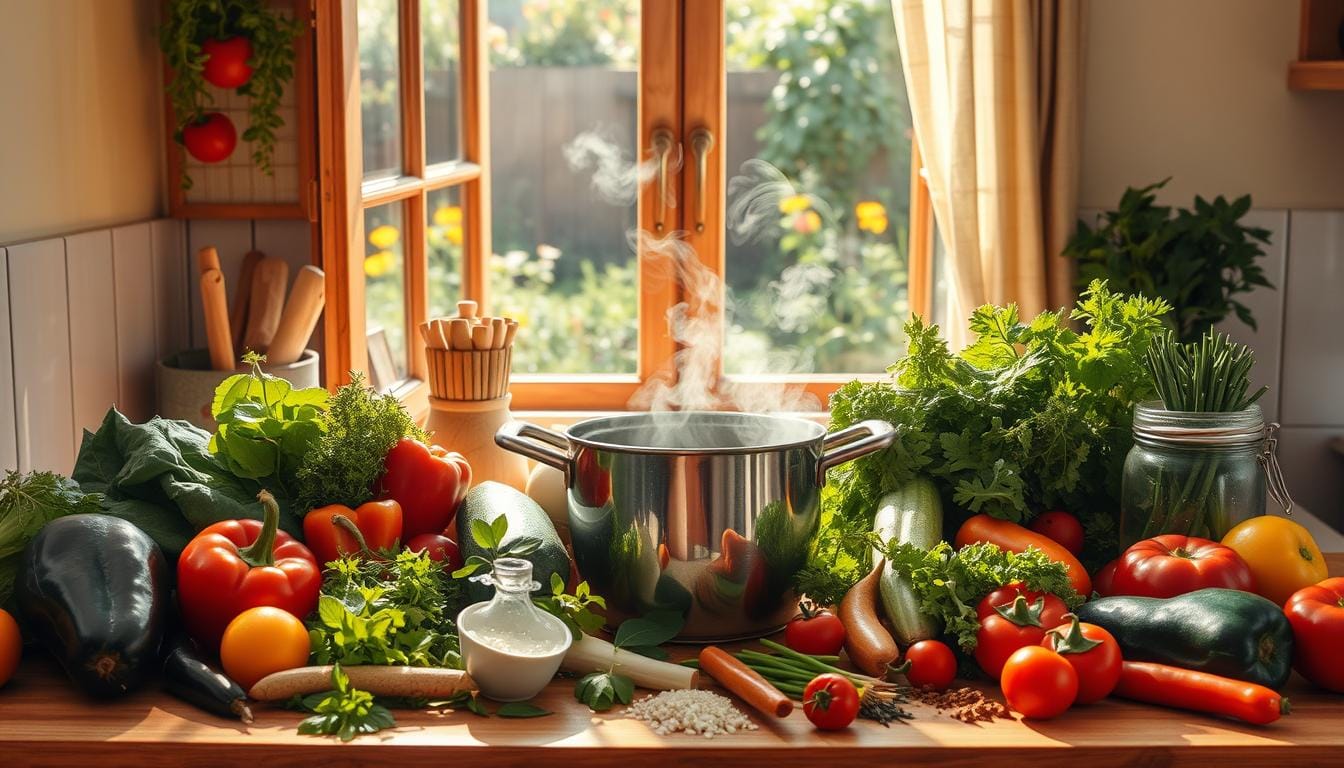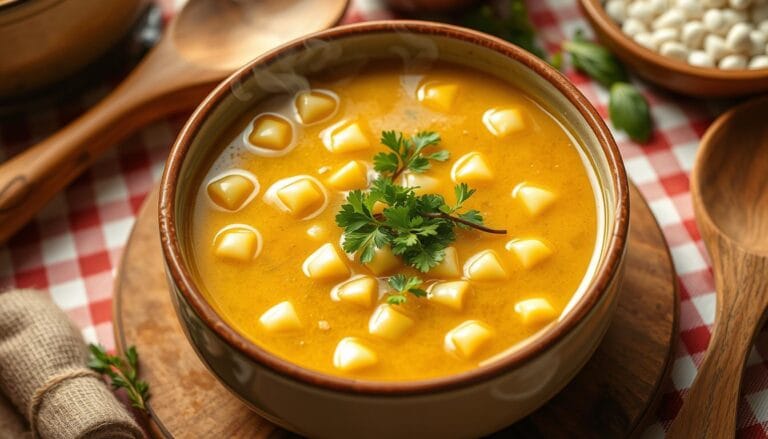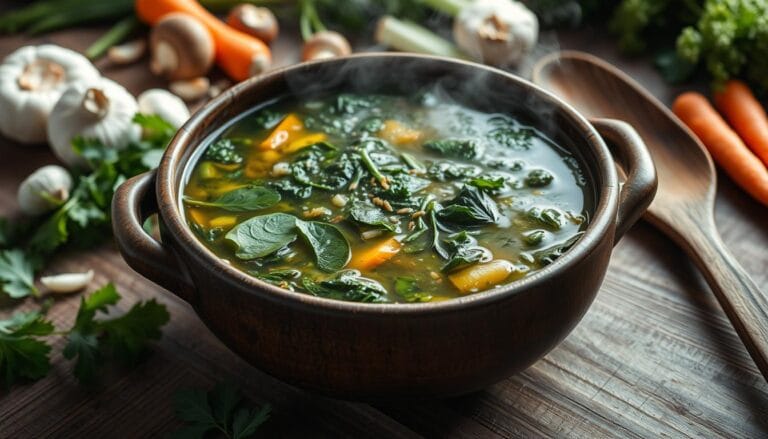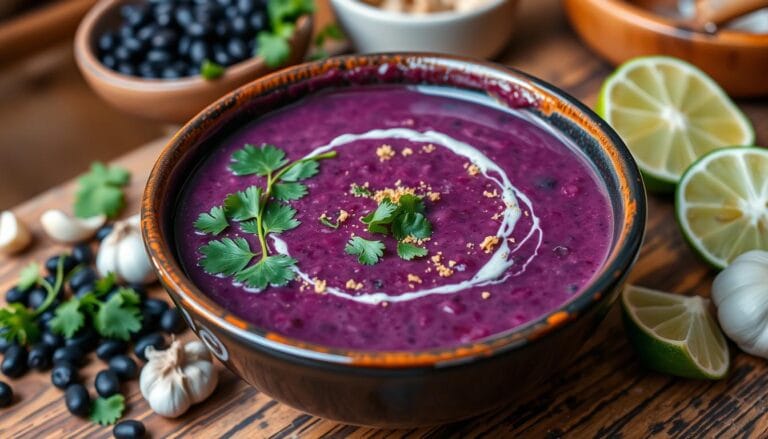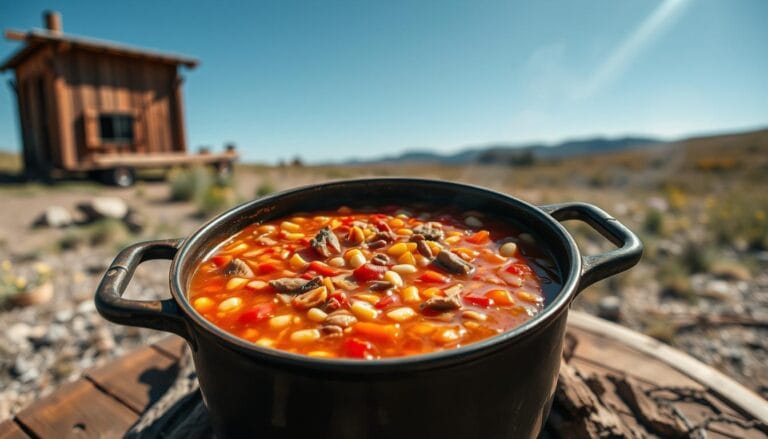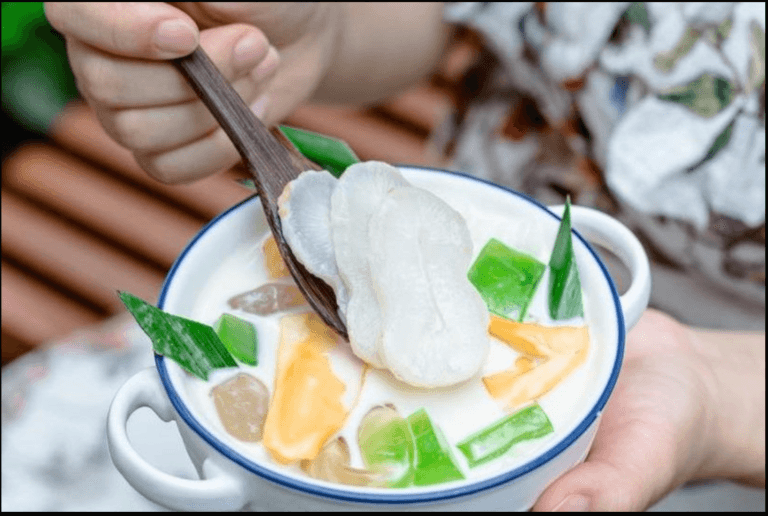Soup recipes abiotic factor & Cooking Tips
Winter’s chill brings a perfect time for a warm bowl of homemade soup. But have you thought about how your surroundings affect your soup’s taste and texture? Abiotic factors, like water quality and kitchen temperature, are key. They can change your soup’s flavor and feel.
Table of Contents
Understanding Abiotic Factors in Culinary Science
Cooking and making recipes are greatly affected by the environment around ingredients and cooking. These non-living, or abiotic, factors are key to the quality and taste of your dishes, especially soups. Understanding how temperature, pH levels, and mineral content of water affect your cooking is vital for mastering soup-making.
Key Elements of Non-Living Components
Environmental factors in cooking go beyond just temperature. Altitude, humidity, and air pressure also play a role. Knowing these factors helps you adjust your recipes and techniques for better soup quality, no matter the environment.
Role of Environmental Factors in Cooking
The environment where you cook greatly affects your ingredients. For example, cooking at high altitudes means adjusting cooking times and temperatures. In humid places, herbs and spices might release flavors differently. Understanding these factors is key to getting the right flavors and textures in your soups.
Impact on Ingredient Quality
The quality of your ingredients depends on their environment. Soil, water pH, and mineral content all influence nutrient and flavor levels. By considering these factors, you can choose the best ingredients for your soups, making them both tasty and healthy.
“Mastering the art of soup-making requires an in-depth understanding of the non-living components that shape the culinary landscape. From temperature to pH levels, every abiotic factor plays a crucial role in the quality and outcome of your creations.”
Water Quality and Its Effect on Soup Preparation
Water quality is key to the texture and taste of your soups. Over 80% of the world’s people eat soup every day. It’s important to know how water affects this favorite dish.
Hard water can make soups taste chalky or gritty. Soft water might make them too thin. You can tweak your recipes to match your water’s quality.
The minerals and pH in water change how soups taste and how ingredients mix. You can adjust water amounts, use filters, or add lemon or vinegar. This helps balance flavors and makes your soup better.
| Water Characteristic | Impact on Soup | Recommended Adjustments |
|---|---|---|
| Hard Water | Chalky or gritty mouthfeel | Reduce water quantity, use filtration, add acidic ingredients |
| Soft Water | Thin, watery broth | Increase water quantity, use mineral-rich ingredients |
Knowing your water quality and making the right changes can make your soups better. Focus on the minerals and pH in your water to improve your soup-making.
“The secret to a perfect soup lies in the quality of the water you use.”
Temperature and Pressure Considerations for Perfect Soups
Making the perfect soup means knowing how temperature and pressure affect cooking. These factors can greatly influence the taste and texture of your soup. It’s especially important when you’re cooking in different climates.
Heat Distribution Methods
How heat spreads in the cooking pot is key for soup making. Slow, even heat helps flavors blend and ingredients soften evenly. Methods like simmering, braising, and pressure cooking help achieve this, making soups rich and complex.
Pressure Impact on Cooking Times
Pressure cooking is a big help, especially at high altitudes. At higher altitudes, water boils at a lower temperature, making cooking take longer. But, pressure cooking can raise the boiling point and shorten cooking times. This makes it a great tool for adapting to different climates.
Adjusting Recipes for Climate Conditions
To get consistent results, you need to tweak soup recipes for your local climate. You might change the amount of liquid, cooking temperature, or even the ingredients. This helps account for things like humidity, air pressure, and what’s in season. By understanding these factors, you can make soups that fit your local taste perfectly.
| Abiotic Factor | Impact on Soup Preparation | Recommended Adjustments |
|---|---|---|
| Temperature | Affects boiling point, cooking time, and ingredient texture | Adjust cooking temperature and time to achieve desired results |
| Pressure | Influences boiling point and cooking time, especially at high altitudes | Use pressure cooking to reduce cooking time and ensure consistent results |
| Climate Conditions | Impacts ingredient availability, texture, and overall dish characteristics | Modify recipes to account for seasonal variations and local climate factors |
Understanding the connection between temperature, pressure, and climate helps improve your soup making. Whether you’re a home cook or a professional chef, you can create soups that are perfectly suited to your local environment.
Soil Composition and Ingredient Selection
When making soups, the quality of your ingredients matters a lot. The soil where they were grown plays a big role. The soil’s pH, mineral content, and organic matter affect the taste, texture, and nutrition of your ingredients.
Knowing about soil composition helps you choose better ingredients for your soups. Using local soil varieties can make your soups unique and show off the best of your area’s natural resources.
Did you know that protease inhibitors in foods like legumes and grains can be 2-10% of the protein? These inhibitors can change how we digest and absorb nutrients. Also, lectins and tannins in fruits, vegetables, and nuts can affect protein and enzyme activity.
The mineral content of the soil is also key. Nutrients like iron and zinc can be influenced by cyanogenic glycosides, oxalates, and phytates in some ingredients. Knowing this can help you pick the best ingredients and make your soups more nutritious.
By using local soil, you can make soups that taste great and are good for you. So, when planning your soup menu, think about how soil composition can improve your dish.
| Soil Component | Affected Ingredients | Potential Impact |
|---|---|---|
| Protease Inhibitors | Legumes, Grains, Tubers | 2-10% of total protein, affecting digestibility |
| Lectins | Beans, Peas, Carrots, Tomatoes | Significant portion of plant proteins |
| Tannins | Tea, Cocoa, Grapes, Apples | Protein binding, impact on mineral absorption |
| Cyanogenic Glycosides | Cassava, Cocoyam, Bamboo | Produce toxic hydrogen cyanide upon hydrolysis |
| Oxalates | Spinach, Rhubarb, Beet Greens | Form insoluble salts with minerals, reducing bioavailability |
| Phytates | Legumes, Cereals, Nuts, Seeds | Bind to minerals like zinc, calcium, and iron, limiting absorption |
Soup Recipes Abiotic Factor: Essential Guidelines
When making tasty soup recipes, it’s key to think about abiotic factors. These factors help ensure your soup tastes great everywhere. You’ll need to tweak things like water ratios and cooking methods for different places.
Basic Recipe Components
The heart of any good soup is its main ingredients: broths, veggies, and proteins. But, how you prepare these can change based on your cooking spot. For example, the taste and texture of your broth can be affected by local water quality.
Also, picking and preparing fresh veggies might need to adjust based on your area’s soil and sunlight. This ensures your soup tastes just right.
Cooking Techniques for Different Environments
Adjusting your cooking ways to fit your local spot is crucial. Things like altitude and temperature can change how long and how evenly your soup cooks. Knowing these can help you get your soup just right, whether it’s a warm stew or a cool gazpacho.
Working with abiotic factors and your soup-making is like a dance. Keep these tips in mind to make soups that are not only delicious but also show off your local area’s unique tastes.
Regional Climate Impact on Soup Making
The climate where you live greatly affects how soups are made and what ingredients are used. Knowing about different climates helps you make soups that taste great and feel right.
In cold places, people often make thick, warm soups. These soups are comforting and full of energy. They often include potatoes, root veggies, and tougher meats. In hot, humid areas, people prefer light soups. These are often chilled or broth-based and filled with fresh, local produce.
It’s important to adjust your soup-making to fit your local climate. Changing the spice levels, cooking times, and methods can make a big difference. This way, your soups will taste amazing and fit the weather perfectly.
Also, using local, seasonal ingredients is key in soup making. Markets and farms in your area offer fresh, tasty produce. Using these ingredients not only makes your soups better but also helps your local food scene and the planet.
| Regional Climate | Soup Characteristics | Preferred Ingredients |
|---|---|---|
| Cold Climates | Hearty, warming soups | Potatoes, root vegetables, heartier meats |
| Hot and Humid Climates | Lighter, chilled or broth-based soups | Fresh, seasonal produce |
By understanding how climate affects soup making, you can make dishes that truly reflect your local food traditions.
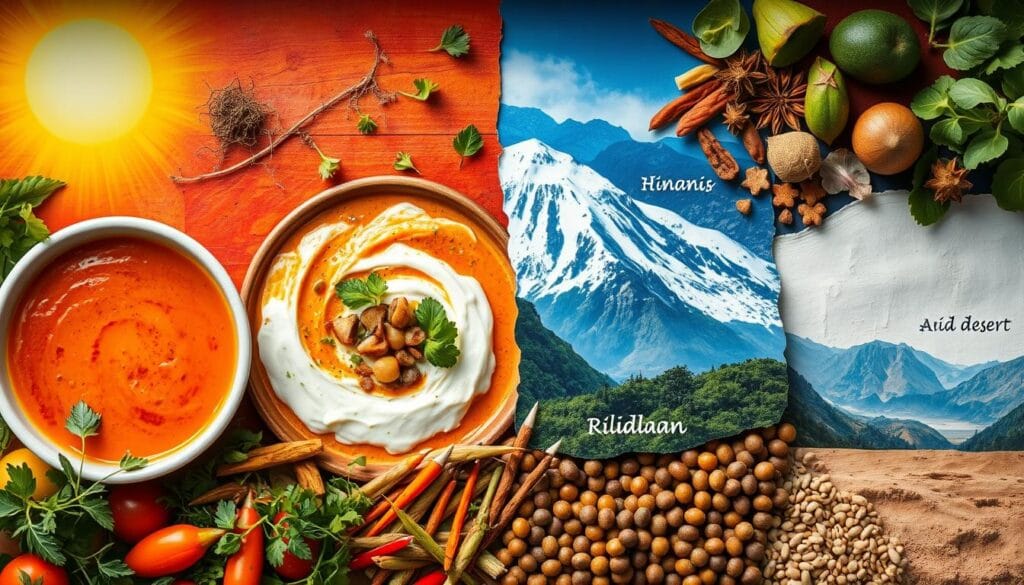
Seasonal Variations in Soup Preparation
Making delicious soups changes with the seasons. As the weather and what’s in season change, cooks must adjust their recipes. This way, they can truly capture the spirit of each season.
Spring and summer soups are light and full of fresh flavors. They use ingredients like asparagus, peas, and zucchini. Herbs and citrus add a bright touch to these soups.
Fall and winter soups are richer and more comforting. They use beef or bone broth and include root vegetables and grains. Seasonal variations in ingredient selection and temperature adjustments are key to these soups.
Understanding seasonal variations helps you make better soups. By choosing the right ingredients and adjusting cooking temperatures, you can impress everyone all year round.
Environmental Sustainability in Soup Making
The world is waking up to its environmental impact, and the food industry is key in this change. Soup making is a big part of this, offering many benefits. These include less carbon footprint, supporting local ecosystems, and boosting local economies.
At the heart of sustainable soup making is using sustainable sourcing for local, seasonal ingredients. This choice cuts down on transportation and storage impacts. It also supports local farmers and keeps the food’s natural taste and nutrients.
Using local ingredients also helps biodiversity. It encourages growing and eating traditional foods. This makes the local ecosystem healthier and more resilient to changes.
| Sustainable Ingredient | Environmental Impact | Nutritional Benefits |
|---|---|---|
| Locally-sourced legumes | Reduced carbon footprint, supports local agriculture | Rich in protein, fiber, and essential minerals |
| Seasonal root vegetables | Adaptability to local climate, low-input farming | High in vitamins, antioxidants, and complex carbohydrates |
| Heirloom grains | Preservation of biodiversity, support for traditional farming | Unique nutrient profiles, high in fiber and complex carbohydrates |
Working with the local community in sourcing ingredients helps soup makers. It strengthens local economies and builds a deeper connection to environmental conservation.
Environmental sustainability in soup making is complex. It involves choosing ingredients, cooking methods, and community involvement. By adopting these practices, soup lovers can enjoy their meals while helping the planet.
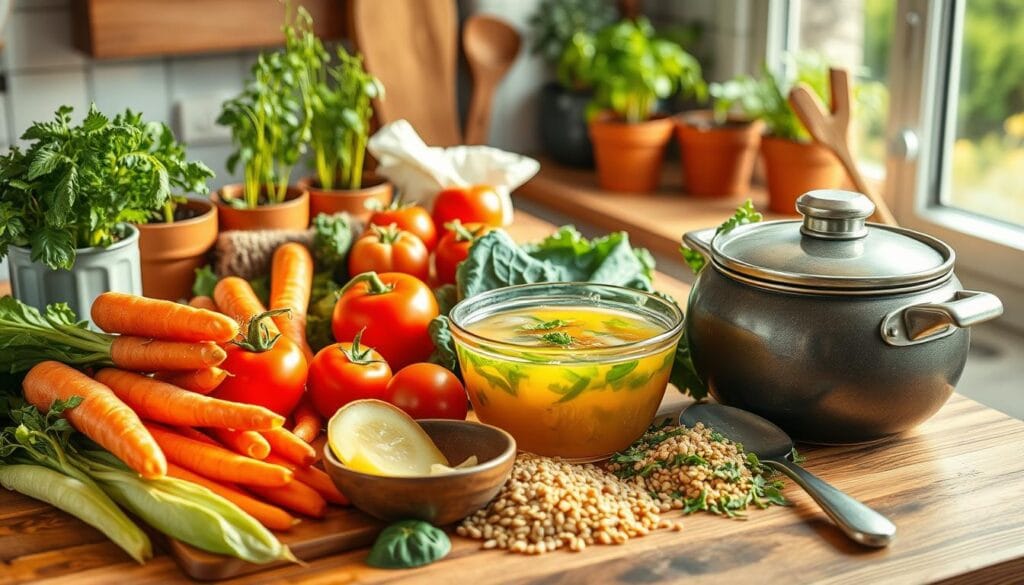
Conclusion
Mastering soup making means knowing a lot about abiotic factors. These factors affect the quality of ingredients, how we cook, and the taste of our soups. By understanding water quality, temperature, and more, you can make soups that taste great and connect with nature.
Adjusting recipes for different climates and using seasonal ingredients can make your soups better. It also helps the environment. By thinking about abiotic factors in your cooking, you’ll make soups that are not just tasty but also meaningful.
Whether you’re making thick stews or light broths, knowing about abiotic factors is key. It lets you create soups that are not just delicious but also nourishing. By taking a holistic approach, your soups will show the beauty of nature and human creativity together.
Have you tried our recipes and liked them? Leave us a review
There are no reviews yet. Be the first one to write one.
